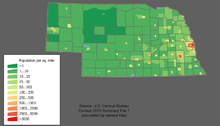Nebraska
![]()
The title of this article is ambiguous. For other meanings, see Nebraska (disambiguation).
Nebraska (English pronunciation [![]()
![]() nɪˈbɹæskə]) is a U.S. state of the Midwestern United States. The name Nebraska comes from the Oto or Omaha language meaning "shallow water". The name comes from the Platte River, which flows through the state. Originally part of the Great American Desert, Nebraska is now one of the largest producers of agricultural products. This is also evidenced by Nebraska's nickname: Cornhusker State.
nɪˈbɹæskə]) is a U.S. state of the Midwestern United States. The name Nebraska comes from the Oto or Omaha language meaning "shallow water". The name comes from the Platte River, which flows through the state. Originally part of the Great American Desert, Nebraska is now one of the largest producers of agricultural products. This is also evidenced by Nebraska's nickname: Cornhusker State.
The people of Nebraska have used modern agriculture to transform the prairie plains into a land full of ranches and farms. As a result, Nebraska's recent history is deeply tied to agriculture.
Geography
Nebraska's bordering states are South Dakota to the north; Iowa and Missouri to the east, beyond the Missouri River; Kansas to the south; Colorado to the southwest, and Wyoming to the west. Nebraska's largest city is Omaha; Nebraska's capital is Lincoln. The state is divided into 93 counties.
Nebraska is located in the middle of the Great Plains at the western foothills of the Corn Belt and is predominantly counted as part of the Midwest. One of Nebraska's slogans is "Where the West begins".
A special feature is that, no matter in which direction, at least three borders to other states or the state borderto Canada have to be crossed to get to the sea.
Structure
→ Main article: List of counties in Nebraska

Nebraska population density by county
History
Native Americans inhabited the area for thousands of years. In the 1690s, French and Spanish came to the area. The Spanish established contacts with the Apache. By 1703, France had established trade relations with all the peoples who lived along the Missouri River in Nebraska. By 1719, France had signed treaties with many of these peoples. Chief among them were the Omaha, Missouria, Ponca, Pawnee, Otoe, and various sub-tribes of the Lakota Sioux. Later, when Spain was at war with France (Seven Years War), Pawnees and Otoes fought on the side of the French and defeated the Spanish.
In 1819, the United States established Fort Atkinson as the first army post across the Missouri River. The Kansas-Nebraska Act went into effect on May 30, 1854, with the result that the land became part of the United States, initially as the Territories of Nebraska and Kansas.
In the 1860s, the first wave of settlers came to Nebraska through the Homestead Act to take possession of land provided by the government. Nebraska was admitted to the Union as the 37th state on March 1, 1867, shortly after the War of Secession.
By 1880, the population had grown to 450,000. During the Great Migration, African Americans from the South came to Nebraska, essentially to Omaha, where they found physical labor in butcher shops and railroad construction. In Omaha, blacks faced discrimination. Most notably, this occurred at the hands of other poor immigrants who competed with them for the same jobs. In 1912, African Americans established an office of the National Association for the Advancement of Colored People in Omaha.
There has also been a movement for Native rights in Nebraska since the 1960s.
Search within the encyclopedia